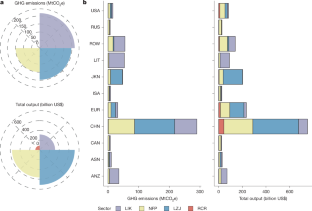Report on Green Technology, Investment, and Trade in Relation to Sustainable Development Goals
This report outlines the key themes of a research article concerning the impact of foreign direct investment on green technology in China. The analysis is framed within the context of the United Nations Sustainable Development Goals (SDGs), highlighting the interconnectedness of economic policy, environmental stewardship, and international cooperation.
Core Research Themes and SDG Alignment
The study investigates critical drivers for environmental sustainability, which directly correspond to several key SDGs. The primary focus is on how international economic activities can be leveraged to support green transitions, a central tenet of the 2030 Agenda for Sustainable Development.
Advancing Green Technology for Sustainable Industry and Climate Action
The research on “green technology progress” is fundamental to achieving multiple SDGs. These advancements are critical for:
- SDG 9: Industry, Innovation, and Infrastructure: Fostering innovation and upgrading industrial processes with environmentally sound technologies.
- SDG 13: Climate Action: Developing and deploying technologies that mitigate climate change, directly supporting China’s “two-carbon” objectives (carbon peak and carbon neutrality).
- SDG 7: Affordable and Clean Energy: Promoting technologies that enable a transition to renewable and clean energy sources.
Foreign Direct Investment as a Mechanism for Global Partnerships
The role of “Foreign direct investment” (FDI) is analyzed as a crucial enabler of sustainable development, aligning with:
- SDG 17: Partnerships for the Goals: FDI serves as a primary channel for the international transfer of capital, knowledge, and green technologies from developed to developing nations.
- SDG 8: Decent Work and Economic Growth: Strategic FDI can stimulate sustainable economic growth by investing in green sectors and creating jobs in the green economy.
Trade Openness and Sustainable Economic Models
The consideration of “trade openness” underscores its importance in disseminating sustainable practices and technologies globally. This relates to:
- SDG 12: Responsible Consumption and Production: Open trade can facilitate the adoption of circular economy principles and more sustainable production patterns.
- SDG 17: Partnerships for the Goals: It enhances the global trading system’s capacity to support sustainable development objectives.
Methodological Framework and Publication Details
Analytical Approach
The study employs a robust quantitative framework to assess the relationships between economic variables and environmental progress. The key analytical components include:
- Feasible Generalized Least Squares (FGLS) for statistical analysis.
- Examination of heterogeneous effects to understand regional and sectoral variations.
This evidence-based approach supports SDG 16 (Peace, Justice, and Strong Institutions) by providing data-driven insights for effective environmental policy and governance.
Bibliographic Information
This report references a correction to an original scientific article. The commitment to correcting the scientific record upholds the principles of transparency and accountability necessary for reliable SDG monitoring.
- Corrected Article Title: The Impact of Foreign Direct Investment on Green Technology Progress in China on Two-carbon Background: Taking Trade Openness into Consideration
- Journal: Frontiers in Environmental Science
- Section: Environmental Policy and Governance
- DOI for Correction: 10.3389/fenvs.2025.1701279
- Original Article DOI: 10.3389/fenvs.2024.1533146
- Authors: Yi M, Xu L, Zhang T, Ao L and Sun M
1. Which SDGs are addressed or connected to the issues highlighted in the article?
Explanation
The article, which corrects a study titled “The Impact of Foreign Direct Investment on Green Technology Progress in China on Two-carbon Background,” touches upon several interconnected Sustainable Development Goals. The core themes of “green technology progress,” “Foreign Direct Investment (FDI),” “trade openness,” and the “two-carbon background” (referring to China’s climate goals of carbon peaking and neutrality) create these connections.
- SDG 7: Affordable and Clean Energy: Green technology is fundamental to developing and implementing clean energy solutions. The study’s focus on technological progress in a low-carbon context directly supports the transition to cleaner energy systems.
- SDG 8: Decent Work and Economic Growth: The article analyzes economic drivers like Foreign Direct Investment and trade openness. These factors are crucial for economic growth, and channeling them towards “green technology” promotes sustainable economic development.
- SDG 9: Industry, Innovation, and Infrastructure: This goal is central to the article’s topic. “Green technology progress” is a form of innovation aimed at making industries and infrastructure more sustainable, resource-efficient, and environmentally sound.
- SDG 12: Responsible Consumption and Production: The adoption of green technologies is a key strategy for achieving sustainable production patterns by reducing waste, pollution, and resource consumption, which is the essence of SDG 12.
- SDG 13: Climate Action: The mention of a “two-carbon background” explicitly links the research to national climate change mitigation strategies. Green technology is the primary tool for reducing greenhouse gas emissions and achieving carbon neutrality goals.
- SDG 17: Partnerships for the Goals: The article examines the role of international financial flows (FDI) and trade in fostering green technology. This directly relates to strengthening the means of implementation and global partnerships for sustainable development, particularly in technology transfer and finance.
2. What specific targets under those SDGs can be identified based on the article’s content?
Explanation
Based on the article’s title and keywords, several specific SDG targets can be identified as directly relevant to the research scope.
- Target 9.4: “By 2030, upgrade infrastructure and retrofit industries to make them sustainable, with increased resource-use efficiency and greater adoption of clean and environmentally sound technologies and industrial processes…” The article’s focus on “green technology progress” is precisely about the adoption of such technologies in industry.
- Target 17.7: “Promote the development, transfer, dissemination and diffusion of environmentally sound technologies to developing countries on favourable terms…” The study analyzes how Foreign Direct Investment, a key mechanism for international partnership, facilitates the progress (and implicitly, the transfer and diffusion) of green technologies in China.
- Target 13.2: “Integrate climate change measures into national policies, strategies and planning.” The “two-carbon background” mentioned in the title refers to China’s national carbon peaking and neutrality goals, which are a clear example of integrating climate change measures into national policy.
- Target 7.a: “By 2030, enhance international cooperation to facilitate access to clean energy research and technology… and promote investment in energy infrastructure and clean energy technology.” The analysis of FDI’s impact on green technology directly addresses the role of international investment in advancing clean energy technology.
3. Are there any indicators mentioned or implied in the article that can be used to measure progress towards the identified targets?
Explanation
The article is an abstract and correction notice, so it does not explicitly list the data indicators used. However, the variables mentioned in the title and keywords strongly imply the types of indicators required for such a study, which would be used to measure progress towards the identified targets.
- Indicators for Green Technology Progress: The study’s central theme implies the use of metrics to quantify “green technology progress.” This could include the number of patents filed for green technologies, expenditure on environmental research and development (R&D), or measures of energy efficiency and carbon intensity of the economy.
- Indicators for International Investment and Trade: The variables “Foreign Direct Investment” and “Trade Openness” would be measured directly. Implied indicators include the total value of FDI inflows and the trade-to-GDP ratio, which are standard metrics for these economic factors.
- Indicators for Climate Action: The “two-carbon background” implies that the ultimate goal is climate mitigation. Progress would be measured by indicators such as total greenhouse gas (GHG) emissions, CO2 emissions per capita, and the carbon intensity of GDP.
4. SDGs, Targets, and Indicators Table
| SDGs | Targets | Indicators (Implied from the article) |
|---|---|---|
| SDG 9: Industry, Innovation, and Infrastructure | 9.4: Upgrade industries for sustainability and adopt clean and environmentally sound technologies. |
|
| SDG 17: Partnerships for the Goals | 17.7: Promote the development, transfer, and diffusion of environmentally sound technologies to developing countries. |
|
| SDG 13: Climate Action | 13.2: Integrate climate change measures into national policies, strategies, and planning. |
|
| SDG 7: Affordable and Clean Energy | 7.a: Enhance international cooperation and promote investment in clean energy technology. |
|
Source: frontiersin.org







